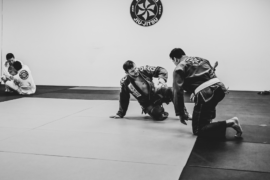THE MEMORIAL COLISEUM IS A MILE AND A HALF FROM NORTH SIDE HIGH SCHOOL, past the DQ where we hung out after tennis practice, and is the home of every public high school graduation in the Fort Wayne area. On a warm seventy-ish degree evening in 1976, a class of three-hundred-seventy-six North Side students marched across the stage, every student’s red and white tassel bearing a special gold “76” Liberty Bell charm in honor of the nation’s Bicentennial. Before the evening was over, a classmate who’d stared in that year’s production of The Sound of Music stood on the edge of the stage and belted out “Climb Every Mountain,” and most seniors, including me, absorbed those lyrics to the bone, our futures seemingly wide open with possibility.
After the ceremony, the matriculated met up with family and friends in the cavernous hallways, encountered hugs, handshakes and plenty of well-wishes before heading off to graduation parties. My own party was held in our basement, which my parents had decorated with red and white streamers and balloons. On a card table, a two-tiered cake with red and white icing stood in the middle, surrounded by gifts and cards bearing cash. It was a wonderful but short-lived evening. The guests ate their cake and ice cream, and then promptly left so I could go to bed—I had to get up early the next day. My friend Roxanne, who lived across the street, also had a party and, like mine, hers lasted long enough to slice the cake, eat it, and say good-bye.
*
The next morning, May 29, Roxanne and I, as well as our teammates Laura and Sarah, who also played doubles, and our coach, parents and other supporters, gathered at the high school and drove north to Elkhart, Indiana, site of the Indiana girl’s tennis regionals. Laura, Roxanne and I had grown up together in the North Highlands addition and had honed our tennis skills at Hamilton Park (named after the famous, feminist Hamilton family—Edith, Alice, Nora and Margaret). At North Side, we met Sarah, who’d gone to another feeder junior high in the more affluent neighborhood east of the St. Joseph River. To this day, we’ve all been good friends.
Roxanne and I won our first match, but Laura and Sarah weren’t as lucky, losing a close battle to a team from Muncie, whom we ended up playing in the second round. Though a tough match, Roxanne and I defeated them, our victory sending us to final match of the day, the winner moving on to the state finals.
All of the in-between moments leading up to that match are lost to memory. We must have muttered about our opponents, which is something competitors do once they arrive at the tournament site and start checking each other out. In tennis, it’s what kind of racquets you play with, and how many you carry in your sport bags, down to the athletic shoes you wear (back then, more than likely Tretorns, Reeboks or Adidas). Because Roxanne and I had played in a few junior tennis tournaments during the summer, requiring us to travel to different cities in Indiana, we knew who the top players were in northern Indiana, and that morning I’d recognized a girl from South Bend, an excellent player I’d watched play in a summer tournament. I knew she’d likely make it to the regional finals.
As for Roxanne and I, all we needed was one more win to qualify us for the semi-state, the final stop before the coveted State Championship.
Before we walked onto the indoor court, I saw the girl from South Bend and wasn’t surprised. I looked around; where was her partner? It wasn’t until we got on the court, unzipped our tennis covers, that I looked across the net and saw Katie’s partner.
We both went over to the viewing gallery.
“Coach, he’s a boy.”
“I know. Don’t let it bother you, just go out and play your best tennis.”
*
During our sophomore and junior years at North Side, girl’s tennis was considered a “team sport.” Area high schools competed against one another and, at the end of the season, the Summit Athletic Conference (SAC) tournament decided the top singles and doubles players. I had played #1 singles those years, and had been captain of the team. My junior year had been especially satisfying because I’d finally beaten my nemesis from South Side High School in a dramatic three-set final to win the SAC. As the sun went down, spectators remained standing around Court 1 as we traded rallies, my opponent and I listening for the ball because we could no longer see it in the shadowed court.
By senior year, girl’s high school tennis in Indiana had been recognized as an official IHSAA (Indiana High School Athletic Association) team sport. Once again, North Side had the depth and confidence to repeat as SAC champions, but this time our victory qualified us to play in regional and, we hoped, semi-states tournaments leading to the State championship in Indianapolis. Instead of playing singles, I decided to team up with Roxanne and play doubles to increase our chances of getting farther in our first, and only, IHSAA State Tournament.
*
When I was a freshmen in junior high, Title IX of the Education Amendments of 1972 was enacted into law, prohibiting federal funded institutions from discriminating against students or employees based on sex. Rep. Patsy Mink of Hawaii was the primary author and sponsor of the bill, and Rep. Edith Green of Oregon and Sen. Birch Bayh of my home state made significant contributions. President Richard Nixon signed the amendment into law. 2022 marked the 50th anniversary of Title IX.
*
Roxanne and I frequently hung out at each other’s houses, eating dinner wherever we happened to land, and doing dumb shit like trying to pull out shrubs with a rope attached to my bicycle. After she’d transferred to Price Elementary, the neighborhood public school, we began to meet the boys in the grassy church lot behind her house, where we learned to play football and, in her driveway, basketball. There wasn’t a day we didn’t play some kind of sport with the boys, who became our mentors and coaches. They expected us to play at their level, and didn’t care that we were girls—a few years later in junior high, however, the extra hands-on grabs and blocks were momentarily flirtatious as they tried to prevent us from shooting or catching the ball.
Down at the park, a new group of boys shared our love of tennis, and our mixed doubles matches with them were always hotly-contested battles. We girls were expected to hold our own—and we did. Playing and practicing with those boys greatly enhanced our skills and made us better players than had we only practiced against each other. In the summers leading up to high school, we partnered with them in mixed doubles, competing in, and winning, local City tournaments for our age groups. I can’t imagine those summers on the tennis courts without our coed partners.
*
Because of Title IX, Andrew had been allowed to play on the girls’ tennis team that year due to his parochial school in South Bend not having enough participants to make up a boy’s tennis team. He was not the only boy who played on a girls sports team that year: four of his classmen played on his school’s girls’ volleyball team.
Title IX offered many girls and women equal opportunities in sports and employment, but it was not bullet-proof; it likewise offered the Andrews of the sports world entrée into women’s sanctioned sports. Even today, it is not immune from controversy. The U.S. Department of Education’s website (www2.ed.gov), states: “Title IX protects people from discrimination based on sex in education programs or activities receiving federal financial assistance” [italics mine]. “People” does not necessarily mean “women.” The debate over allowing transgender athletes to compete in women’s sports has once again put Title IX in the spotlight. According to Billie Jean King’s website (www.billiejeanking.com): “The law opened doors and removed barriers for girls and women, and while female athletes and their sports programs still have fewer teams, fewer scholarships, and lower budgets than their male counterparts, since Title IX’s passage, female participation at the high school level has grown by 1057 percent and by 614 percent at the college level.” But as King mentions, even though the doors were opened, the playing field is often still unequal and/or controversial.
*
During our three years at North Side, the girl’s tennis team always had the support of teachers, staff, students and parents. Teachers regularly showed up to watch our home matches, and even the principal strolled over now and then and stood by the fence to watch. Members of the boy’s tennis team, as well as boys and girls from other teams, came by to lend their support.
Did that mean North Side followed Title IX to the letter? When girls’ teams would be on the road and stop for food, it was McDonald’s to-go, while the boys’ bus pulled up to Ponderosa, where their team was seated comfortably and ate balanced meals. Our equipment and uniforms were reused from year to year. The girl’s tennis and volleyball teams shared the same all-white, no-sleeved, plain-as-Jane tennis dresses. The boys got regularly updated and replaced uniforms.
North Side’s girls’ gym was a small rectangle of gray brick with a wooden floor. The boys’ gym was a mini-Coliseum, its floor sunken, with ascending rows of red plastic benches reaching up to the top of the domed ceiling. They had a weightlifting gym and updated locker rooms. I remember waiting to take our turn to practice in our own gym. It was early spring and too cold and rainy to go out on the tennis courts. So, our practice was hitting balls against the smooth brick wall. But on that inclement day, we waited—until the boy’s track team finished running sprints on the wooden floor; until the hurdlers practiced a few hurdles; until the relay teams worked on their handoffs; until the boy’s baseball team practiced pitching and catching. Only then did we get access to our own gym.
*
“But, he’s a boy.”
“Just forget who’s on the other side. Go out and play your game. Your own game.”
In between points, Roxanne and I conferred on our strategy. Hovering near the back curtain, we whispered, “This isn’t fair.” Then gritted our teeth and said, “Come on, let’s go!”
Andrew was good, but not as good as his partner, Katie. Still, Roxanne and I had played our share of mixed doubles and knew you played to the weaker shot and, in mixed doubles, that was generally the female’s backhand. Instead of hitting to Andrew and letting him make the mistakes, we naturally hit to Katie—a “psych” thing” we couldn’t seem to overcome. Katie proceeded to pound the ball back, her placement superbly striking the corners, pulling us out of position for easy cross-courts or net volleys.
We lost in two straight sets. Katie and Andrew advanced to State, where they won the title match, becoming the IHSAA Girl’s State Doubles Champions. In the IHSAA Handbook, you can see their photo along with this caption:
Catherine [*] & Andrew [*][1]
South Bend [*] High School
1976 State Tennis—Girls Doubles Team
Looking at the photo today, I see a young man with brown wavy hair touching his ears, a boy with the clean-cut features of Donny Osmond—a boy who, under any other circumstances might easily have caused Roxanne and I to crush. But back then, we saw him as an unfair opponent, a roadblock to our goal, and our drive home was somber and confused. As our coach drove, she tried to explain “Title IX.” We said, “Title what?”
*
Recently, on Twitter, Tulsi Gabbard was defending Title IX in the run-up to the amendment’s 50th anniversary. What prompted Gabbard’s defense was the issue of transgender athletes, like Lia Thomas, competing in women’s sports. I went to Gabbard’s website and explained what had happened to my friend and I years ago. Over the years, I’d mention our experience to friends and family and receive the same head shakes, the same question: How could that happen? But in playing a coed team, Roxanne and I had already slipped to a footnote in the history of Hoosier high school girl’s tennis.
When Thomas, a transgender athlete on Penn University’s women’s swim team, began trouncing her competition, disgruntled persons, including some high-profile athletes, questioned whether Title IX had been compromised in a twist of gender-politics. Nancy Hogshead-Makar, a former Olympic gold medalist in swimming, and a lawyer who represents student-athletes and universities in Title IX matters, came out publicly against Thompson’s participation. Though I received no response from Gabbard or her staff, I decided to reach out to Hogshead-Makar with my story. Nancy is currently the CEO of Champion Women, a non-profit organization that, according to its website, “provides legal advocacy for girls and women in sports.” As an aside: I met Hogshead-Makar years ago, in person, when she and my husband were both part of a wedding party; the groom was my husband’s friend, the bride a college friend of Nancy’s. I included our brief personal connection. She responded quickly, fondly remembered our connection, and encouraged me to get involved with her organization via a link she provided. (I did share the linked information on Twitter.) I have since seen Hogshead-Makar interviewed on PBS and other TV stations, and while I agree with her stance concerning Title IX and transgender athletes, she didn’t seem particularly interested in my story.
Title IX is well-intended, but ultimately it fails to protect all athletes.
*
After I’d graduated from college, a tennis friend asked me if I’d help her coach her high school alma mater’s girl’s tennis team. The parochial school had always had a solid program, and my friend and her sisters had been fierce competitors I’d had to play throughout my tennis career.
Our girls won the SAC, and then proceeded to earn a berth in the State finals. In the van driving south on I-69, I had bittersweet thoughts of how Roxanne and I might have taken this same journey had we beaten Katie and Andrew years earlier. Though I’d never be a State champ, it was possible I could help coach a group of wonderful girls to win the State Championship and at least have a toehold in the IHSAA history books.
We were paired against Indianapolis Brebeuf, a powerhouse preparatory school—and immediately got trounced. Dejected, teary-eyed, the girls marched back on the court and won the loser’s bracket, which gave them a highly-commendable third-place finish.
After that year, our coaching careers were over. My friend had long held a desire to join the Missionaries of Charity, the Roman Catholic religious congregation founded by Mother Teresa, and in keeping her vows of obedience, chastity and poverty gave up her beloved tennis racquet and short tennis-skirts. I continued my job as an editorial assistant—my first real job out of college—and met the young man who would become my husband. Before the year’s end, I ended up quitting my job, walking out one morning with no other job lined up because my boss, a former college professor who’d started his own magazine, left typed messages in my desk at work, so that when I came back from lunch, I’d find his sexual suggestions of what we might do together outside of the office.
*
Years later, I tried playing competitive tennis in a USTA league. I was forty years old. Our team won the local and state level and proceeded to the regionals in Indianapolis where winners from the Midwest played to advance to the Nationals. We lost our first match. I’d had enough of competition to remind me of what I hadn’t missed. Since then, I haven’t picked up a tennis racquet, though every time I go to a high school class reunion, I’m inevitably asked by classmates if “I’m still playing tennis.” No, I say, smiling. Sometimes I think that if I could go back to that match in Elkhart, I would have put up a little more fuss about stepping on the court and having to play a girl and a boy for the “girl’s tennis regional” title. I now understand why Andrew was allowed to play on a girls’ team, but I would have expected a full explanation why his school didn’t have a boys’ team. Tennis in the 70’s, if you didn’t know, was hugely popular. Think: Bjorn Borg, Arthur Ashe, Jimmy Connors, John McEnroe, Billie Jean King, Chris Evert, Martina Navratilova. Surely, there were other young men at that South Bend high school who might have helped Andrew form a men’s tennis team. The only real question I still have is this: If Andrew has his plaque/trophy displayed prominently (as I would have had I won State), how does he explain to people who ask about the inscription: “1976 State Tennis—Girls Double Team”?
[1] Last names and school name withheld for privacy
DS LEVY lives in the Midwest. Her fiction has appeared in many journals and has received Pushcart and Best Microfiction nominations. She has had work included in Wigleaf’s Top 50 2021, and Long List 2022. She was a finalist in the 2022 Jeanne Leiby Memorial Chapbook Award at The Florida Review. In the way back, she used to be a competitive tennis player, coach and instructor.
Like what you’re reading?
Get new stories, sports musings, or book reviews sent to your inbox. Drop your email below to start >>>
NEW book release
Ghosts Caught on Film by Barrett Bowlin. Order the book of which Dan Chaon says “is a thrilling first collection that marks a beginning for a major talent.”
GET THE BOOK



